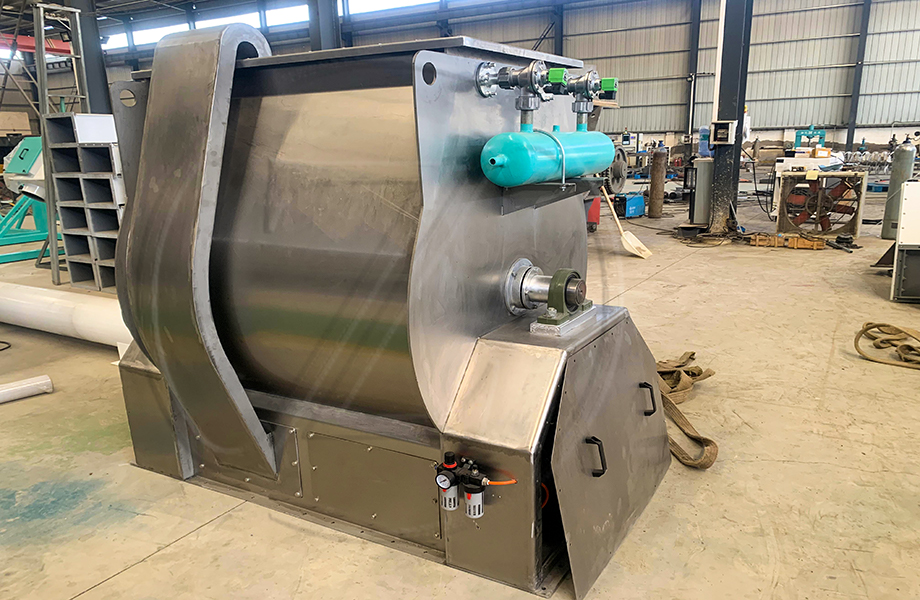- Zhengzhou City, Henan Province China
- Telephone: 0086-16637162658

⚪Customization&OEM
⚪ Tailored Solutions, Customized Plans.
⚪Install with precision and expertise.
⚪Support throughout and beyond.
Introduction of SLHS Shaft Paddle Mixer:
The SLHS Shaft Paddle Mixer is a mixing equipment primarily used for batch blending of different granular or powdered materials. Its key feature lies in the utilization of a paddle agitator attached to a shaft, typically mounted on a single axis.
As the shaft rotates, the paddles move within the mixing trough, thoroughly blending the raw materials to ensure uniformity in the mixture.
Why use SLHS Shaft Paddle Mixer?
Uniform Mixing: Through the rotation of the shaft and the use of a paddle agitator, the SLHS Shaft Paddle Mixer achieves uniform blending of different granular or powdered materials, ensuring consistency in the mixture.
Versatility for Various Materials: This mixing equipment is suitable for a variety of granular or powdered materials, exhibiting high versatility to meet production requirements across different industries.
Batch Mixing: The SLHS Shaft Paddle Mixer is typically employed for batch mixing processes, making it suitable for large-scale production and enhancing overall production efficiency.
Controllable Mixing Time: Operators can adjust the mixing time as needed to ensure that the mixture reaches the desired level of uniformity.
Simple and Easy to Clean Structure: The equipment has a relatively simple structure, making it easy to clean and maintain, contributing to improved reliability and extended equipment lifespan.
Energy Savings: Compared to some other mixing equipment, the design of the SLHS Shaft Paddle Mixer often allows for energy savings, enhancing the economic efficiency of production.
Technical Parameters
| Model | Power(kW) | Capacity(kg/batch) |
| SLHS1 | 11 | 500 |
| SLHS2 | 18.5 | 1000 |
| SLHS4 | 30 | 2000 |
Working Principle:
This mixer is primarily composed of two counter-rotating shafts arranged in a specific phase and equipped with paddles mounted on the shafts.
Driven by a motor, the paddles on one side of the shaft lift the materials and rotate them, while the paddles on the other side utilize the phase difference to lift and rotate the materials in the opposite direction.
As a result, the materials from both sides fall into the chambers formed by the two shafts. This creates a fluidized and weightless zone in the central part of the mixer, rotating at a low circumferential speed.
The production process of feed mill :
The Feed Milling Process typically involves the stages of raw material reception and storage, cleaning, crushing, dosing & mixing (batching), pelletizing, cooling, pellet refinement, screening & grading, packaging, and storage. In specific cases where clients have unique requirements for feed pellet production equipment, additional features such as liquid infusion, curing, spraying, extrusion, drying, and more may be integrated.

Do you know the production process of a feed manufacturing plant?
1.Raw material storage :
Given the diverse array of ingredients in animal feed, various types of silos are essential. The feed pellet production line can employ three types of silos, namely hopper silos, flat-bottom silos, and galvanized silos.

Primarily employed for eliminating impurities from feed raw materials, particularly large, medium, and ferrous impurities, aiming to achieve the following objectives:
○ Safeguarding both equipment and workers,○ Enhancing the quality of feed products, and ○ Ensuring secure and efficient equipment operation.
In accordance with the process flow and raw material composition of feed production, it is necessary to crush the raw materials to the required particle size.

4.Dosing equipment:
mainly used for dosing various raw materials, mixing materials evenly, including manual dosing type and automatic dosing type.
mix the feed ingredients thoroughly. This stage demands short blending cycles, high mixing quality, rapid discharge, low residue rates, excellent airtightness, and zero dust spillage.

6.Pellet Mill:
This process is to press out the pellets, the finished pellets are good palatability, storage resistance, there are two kinds of flat model and ring model, feed mills mainly use ring die pelletizing machine.

7.Cooling Equipment:
When pellets are extruded from the pellet machine, their moisture content reaches approximately 16%, and the temperature can reach 80-90 degrees Celsius. To facilitate pellet storage, the cooling process is indispensable.
8.Pellets Crusher / Breaker / Bucker :
Break the pellets into small particles.It is mainly used for chicken feed pellet line.
9.Screening Equipment:
After the pellet feed undergoes the crushing process, certain undesired materials such as powder are generated. This process primarily involves separating the non-conforming pellets and powder, allowing the qualified pellets to proceed to the next stage of production.
This includes both automatic packaging machines and manual packing machines.

11.Dust Removal Equipment:
Essential for eliminating dust and ensuring environmental protection.
12.Conveyor: for conveying feed ingredients, semi-finished and finished feeds
Real Shot



Get An Instant Quotation For all inquiries fill in the form below to send us a brief message,and we will get back to you as soon as possible.
Henan zhongzhenxing Machinery Equipment Co.,Ltd. Your dedicated partner in custom feed processing solutions. With a rich legacy spanning over a decade, we specialize in tailoring comprehensive equipment sets to meet the unique production needs of small, medium, and large-scale feed operations.